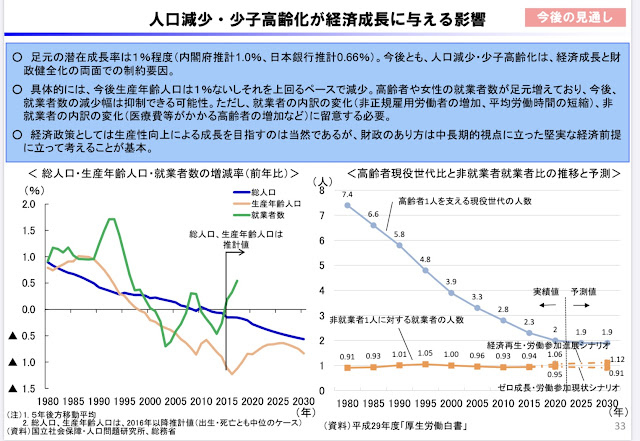いやあボクは、「 私は氏の見解をほぼ全面的に受け入れている者だが」としたように「ほぼ」であってね、藤巻氏は投資家であってそこまで求める必要はないかもしれないけど、日本という国の「人口動態」に触れている記事やツイートには行き当たったことはないね。
以前にも二度ばかり掲げたことがあるが、白川方明前日銀総裁の分析を貼り付けておくよ。
…………
|
白川方明前日銀総裁は、2014年、米国のビジネススクールで講演して次のように言っている。 |
|
日本経済の主な問題はデフレではなく、人口動態である[The main problem in the Japanese economy is not deflation, it's demographics] (白川方明 Masaaki Shirakawa, at the Tuck School of Business at Dartmouth College, 2014.05.13) |
|
これは彼がまだ日銀総裁だった時期(氏は2013年3月退任)にも繰り返し言っていたことで、例えば2012年にはこう言っている。 |
|
日本の実質GDP成長率は確かに低下し、他の主要国と比較しても見劣りするが、過去10年の平均でみると、人口一人当たりの実質GDP成長率は他の先進国とほぼ同程度、そして、生産年齢人口一人当たりの実質GDP成長率で比較すると、日本が最も高い。(欧米は日本バブル崩壊の轍を踏むか?――日銀・白川総裁が語る世界経済の未来ーー2012年1月10日、英国のロンドン大学経済政治学院に於講演) |
この10年間のスパンでは、生産年齢人口一人当たりの実質GDP成長率は主要先進国で一番高いのに、なぜ実質GDP成長率は一番低いのか。これが人口動態のせいであり、つまり生産年齢人口の急激な減少である。
平成29年の厚生労働省の資料なら次の通り。
白川氏は《欧米諸国は日本と比較すると、人口増加率は高いが、移民による人口増加の寄与度が大きい》としつつ次の表も示している。
先進国民というのはどこも子供産まなくなるのだが、欧米諸国は移民でもっているという図だ。とくにドイツの移民を除いた人口減少が他国に比べて甚だしい。
最初に上げた実質GDP成長率、一人当たりの実質成長率、そして生産年齢人口一人当たりの実質GDP成長率の図にもどれば、財務省は、「平成財政の総括」財務省、平成31年4月17日、pdfにて、より大きなスパンでの図を示している。
この図では、生産年齢人口一人当たりの実質GDP成長率が真ん中になっているが、1990-2016年のスパンでも日本が負けているのはドイツだけであり、生産年齢人口一人当たりでは日本はとても頑張っているのである。失われた20年やら30年やらというのは、この観点からは嘘であり、もし失われた30年ということが言えるなら、失われた生産年齢のパイの影響である。
これはドイツのシンクタンクでも同様の分析をしている。
|
Demographic Lessons from Japan for Europe Daniel Gros 10 November 2017 、PDF |
|
Demography is not destiny, at least not entirely. Over centuries, policy can affect fertility decisions and migration can transform a country, as the experience of the United States shows. Over shorter time horizons, however, demographic trends must be taken as a given, and they still can have a profound impact on growth. Yet demographic factors are often neglected in economic analysis, leading to significant distortions in assessments of countries' performance. Nowhere is this more apparent than in Japan. |
|
With real output – the key measure of economic performance – having risen by only about 15% since 2000, or less than 1% per year, Japan easily seems the least dynamic of the world's major economies. But given Japan's demographics – the country's working-age population has been shrinking by almost 1% per annum since the start of this century – this result is remarkable. |
|
In fact, Japan's growth rate per working-age person was close to 2% – much higher than in the US or in Europe. Although the US economy has grown by more than 35% since 2000, its working-age population has also grown markedly, leaving the annual growth rate per working-age person at only about 1%. |
|
That indicator – growth rate per working-age person – is not widely used by economists, who instead focus on GDP per capita. By that measure, Japan is doing about as well as Europe and a little worse than the US (see Figure 1). But, while per capita indicators are useful for assessing a country's consumption potential, they do not provide an adequate picture of growth potential, because they include the elderly and the young, who do not contribute to production. Even in Japan, with its long life expectancy, those over the age of 70 do not contribute much to output. Figure 2 thus shows that Japan is clearly ahead if one looks at (real) GDP per working age person. |
|
So, given its rapidly declining potential, Japan has been extraordinarily successful. A key reason is that it has put a growing proportion of its working-age population to work: unemployment is today at a record low of less than 3%, and almost 80% of those who are able and want to work have a job, compared to about 70% for Europe and the US. |
「日本は異様なほど成功している」とあるけど、そうなんだな、一人当たり生産年齢人口では。これ以上求め得ないほどに。
ま、この観点からは日本全体としては何したって経済成長はもうムリだよ。いまさら移民政策っていうわけにもいかないし、だいたい移民を促進しても窮屈で低賃金の日本なんかにもうほとんど行かないだろうからな。日本は失われた30年やら40年やらじゃなくて、今後もすくなくとも「失われる100年」は決定的だね、奇跡的な日本固有の技術革新がなければ。





